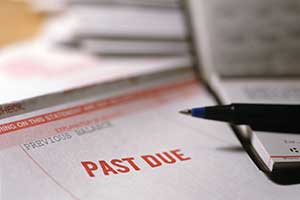
If a Chapter 13 bankruptcy case is dismissed, several things can happen. First, your automatic stay — put in place when you first filed — is no longer in force. That means creditors can once again take action to collect a debt, which can include harassing phone calls and letters, wage garnishment, foreclosures, repossessions, and debt collection lawsuits. You lose your protection from creditors. Next, you may also face new collection activity for any debts that fall into default now that weren’t before. And depending on your attorney and how far along you are in the bankruptcy process, you will still typically have to pay your attorney’s fees even though you won’t achieve a completed bankruptcy or discharge.
To make sure your bankruptcy is successful and your case doesn’t get dismissed, it is very important to follow all the rules of the bankruptcy process, including filing the appropriate paperwork, showing up for court hearings, and meeting all the obligations under your Chapter 13 repayment plan.
What is Chapter 13 bankruptcy?
Chapter 13 bankruptcy is a debt reorganization process that is often the best choice for homeowners with more equity in secured assets than they can protect through Ohio bankruptcy exemptions and who wish to keep these assets. It can also be the right choice for people whose income is too high to qualify for a Chapter 7 bankruptcy. To file Chapter 13 bankruptcy, you must have a regular source of income to meet daily living expenses and to apply toward your Chapter 13 repayment plan.
When you file for Chapter 13 bankruptcy protection, you have the opportunity to repay your debts under better conditions and at lower interest rates. It allows you to use future income to repay your creditors while keeping your house, vehicles, and other property if you choose to. If you have missed mortgage payments and are at risk for foreclosure, Chapter 13 gives you a chance to “catch up” and stop a foreclosure.
Chapter 13 allows you to consolidate your payments to avoid fees and fines. Debts that may be consolidated include secured loans, such as mortgages and balances on vehicle loans, as well as unsecured debts, such as credit card debt and medical bills. You can repay some or all of your debt affordably over a three- to five-year period. Some loans such as second mortgages or vehicles loans can be avoided or modified in a Chapter 13 plan. Harassing phone calls and letters from creditors must stop.
There are several reasons why a Chapter 13 might be dismissed by the court. Some of these include:
- Skipping the meeting of creditors
- Failing to pay the court filing fee
- Not attending required credit counseling
- Proposing a Chapter 13 repayment plan inconsistent with bankruptcy laws
- Missing deadlines
- Not filing tax returns
- Committing fraud in your petition
- Filling out bankruptcy forms incorrectly or not at all
The reasons above are typically within the control of the petitioner and, therefore, failing to do these this is often the fault of the petitioner. However, sometimes things arise that are beyond the control of the petitioner – like losing a job, getting sick, or getting injured – and their financial situation changes. Through no fault of their own, they don’t have the money to make the payments on their plan. In these cases, a Chapter 13 can be dismissed if a petitioner cannot switch to a Chapter 7 bankruptcy.
Can you reopen a dismissed Chapter 13?
What happens when you get dismissed from Chapter 13?
A dismissed bankruptcy petition means your situation becomes more complicated. Generally, you don’t “reopen” a dismissed Chapter 13, but in some cases it’s possible to file a new Chapter 13 petition. Whether you can file a Chapter 13 petition immediately after your previous Chapter 13 was dismissed often depends on why the initial petition was dismissed in the first place. The court will decide if you can file a new petition immediately or you must wait a specified period of time before filing again. Either way, your automatic stay may be diminished.
Can you refile a Chapter 13 after a dismissal?
Steps to refiling a Chapter 13 after a dismissal
These are times when having a skilled and experienced bankruptcy attorney by your side really helps. Chapter 13 bankruptcies are very complicated – certainly more complicated than Chapter 7 bankruptcies – and trying to file a new petition after a previous one is dismissed makes everything more complicated still. Roughly 97% of people who try to file Chapter 13 on their own ultimately have their cases dismissed. That’s why a bankruptcy attorney is essential in these cases.
Depending on why your Chapter 13 is in danger of being dismissed, you may be able to “convert” your petition into a Chapter 7. Your attorney can advise you if this is possible. If the court approves a conversion, you simply file notice with the court and pay a conversion fee.
If your attorney advises you that it is a good idea to file a new Chapter 13 petition immediately after a Chapter 13 is dismissed, there are certain steps you’ll want to take:
- Follow your attorney’s directions to the letter
- Collect all the paperwork and documents necessary to file
- Show up for all court-scheduled meetings
- Don’t make the same mistakes that resulted in a dismissal the first time
Contact our skilled and experienced bankruptcy lawyers today
When it comes to debt relief, the sooner you take action, the better. Delaying only prolongs your financial issues. If you want to file a Chapter 13, or if a previous Chapter 13 has been dismissed, a bankruptcy attorney at Fesenmyer Cousino Weinzimmer may be able to help. We can review your situation, analyze the reasons your initial Chapter 13 was dismissed, and develop a plan of action. A free consultation with us can help you decide what is the best option. Contact us by email or by calling 614-228-4435 (Columbus), 937-222-7472 (Dayton), or 877-654-5297 (Cincinnati). You will receive valuable, personalized insights on debt relief suitable for your situation, with no further obligation.


